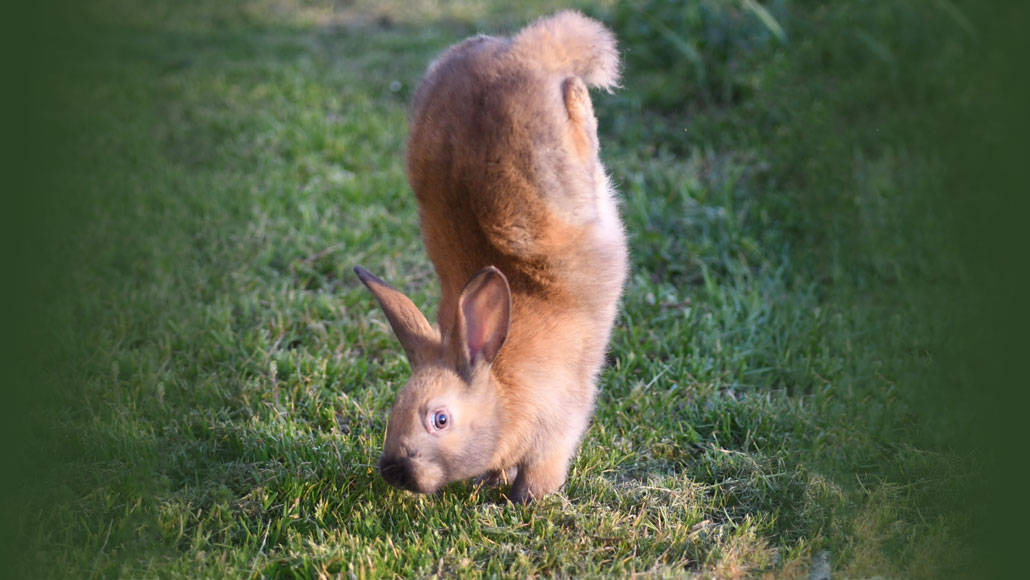These rabbits can’t hop. A gene defect makes them do handstands
Some rabbits throw up their back legs and walk on their front paws to hustle along quickly

Some rabbits walk on their front paws instead of hopping from place to place. The strange gait is the result of a mutation in one gene that helps rabbits coordinate their limbs.
Samuel Boucher
A flawed gene might turn some bunnies’ hops into handstands, a new study suggests.
One breed of domesticated rabbit called sauteur d’Alfort has a funny way of walking. To move quickly, they send their back legs sky high and walk on their front paws. That strange gait may be due to a mutation in a gene that helps limbs move. Researchers reported their finding March 25 in PLOS Genetics.
The gene is called RORB. And sauteur d’Alfort rabbits aren’t the only animals to adopt an odd scamper if there’s a mutation in this gene. Mice with a mutation in RORB also do handstands if they start to run, says Stephanie Koch. She’s a neuroscientist at University College London. She was not involved with the rabbit work. And even while walking, the mice hike their back legs up to waddle forward like a duck, Koch says.
“I spent four years looking at these mice doing little handstands, and now I get to see a rabbit do the same handstand,” Koch says. She led a 2017 study published in Neuron that explored why mice have the ducklike gait. “It’s amazing.”
Figuring out why the rabbits move in such a strange way could help researchers learn more about how the spinal cord works. The new study is “contributing to our basic knowledge about a very important function in humans and all animals — how we are able to move,” says Leif Andersson. He’s a molecular geneticist at Uppsala University in Sweden.
A faulty gene appears to drive the funny gait
In the rabbit study, Andersson and his colleagues bred hop-less sauteur d’Alfort male rabbits with New Zealand white female rabbits that can hop. The team then scanned the genetic blueprints of the offspring. They looked in the young bunnies that couldn’t hop for gene differences from ones that could.
A mutation in the RORB gene popped up as a likely suspect for the rabbits’ acrobatic handstands. That change creates faulty versions of the genetic instructions that cells use to make proteins. As a result, there appears to be less of the RORB protein in special nerve cells that have the mutation as compared to cells without it.
Those spinal-cord nerve cells are called interneurons. They help coordinate the left and right side of the body by passing along nerve signals. Properly working interneurons are key for a normal walk or hop, Andersson says. If the special nerve cells don’t have the RORB protein, the rabbits may not be able to coordinate what their hind limbs are doing. That restricts their ability to hop.
While moving slowly from place to place, rabbits with the defective gene can alternate their front and hind legs to walk normally. But to hustle or to travel over long distances, rabbits hop. Hopping requires synchronized hind legs to jump, says study coauthor Miguel Carneiro. He’s a molecular geneticist at Universidade do Porto in Vairão, Portugal.

Educators and Parents, Sign Up for The Cheat Sheet
Weekly updates to help you use Science News Explores in the learning environment
Thank you for signing up!
There was a problem signing you up.
Without that coordination, all rabbits with a RORB mutation use their front paws to move quickly, Carneiro says. But some hop-less bunnies might do a more drastic handstand than others.
It’s an interesting observation, Koch says. But the study doesn’t reveal much about how interneurons without RORB makes rabbits do handstands. “All they’re looking for is that mutation in one gene and how that gene is affecting the spinal cord.” In fact, she notes, “it could be affecting everything in the rabbit. We have no idea.”
Uncovering how that genetic defect affects the body more broadly could be important for understanding the way animals move. Even people can’t run without harmonized movements of our four limbs. “If you look at the 100-meter sprint — [by] Usain Bolt or someone like that — there’s super coordination between limbs,” Andersson says. “If you lack the coordination between arms and legs … you could never compete for a gold medal.”
These handstand rabbits wouldn’t grab any golds either. But they could help researchers develop ways to repair the body when RORB defects cause disease, Koch says.







